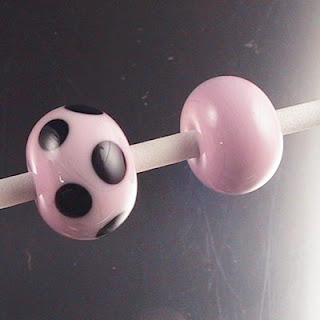 Moretti Super Clear. The very phrase is enough to get one all excited! And ai caramba - sight down the unmelted rod to check the true colour - and the light is white! Blinding.
Moretti Super Clear. The very phrase is enough to get one all excited! And ai caramba - sight down the unmelted rod to check the true colour - and the light is white! Blinding.Soooooo ... here it is. Wow. Sure is clear. Gosh. Lookit that clear bead. No colour whatsoever. I can tell. The massive quantity of bubbles are, in fact, showing up really well.
 At least you can truly see the bubbles as bubbles. Here's another shot of the same bead - from the other side.
At least you can truly see the bubbles as bubbles. Here's another shot of the same bead - from the other side. And here is a large-ish dichro lentil - encased with the same clear. Now really - like this - it doesn't look bad - and I was probably working a little cooler - which definitely helps. But there is still a lot of fog in there.
And here is a large-ish dichro lentil - encased with the same clear. Now really - like this - it doesn't look bad - and I was probably working a little cooler - which definitely helps. But there is still a lot of fog in there.Good thing we don't have to count on Moretti/Effetre for our clear!
Or maybe we need to be more specific about the definition of clear. Not - "can see through it," - but "can't see anything in it." :-(














































